There are a couple of pieces of that puzzle that we have been working on. I’m not prepared today to kind of speak to them, but they’re not insignificant acquisitions. One of the keys to the fact that we know based on what the working capital build and what we expect to collect this year, we’re going to have a pretty significant difference in working capital over the course of the year. Timing of that really is not so much in our control because they’ve got to be willing to accept delivery. Just for purposes of those on the phone, revenue recognition is not necessarily the same as the timing of collections and billings. Revenue recognition is done as work is performed versus billings and collections are based on the milestones in the contracts that are usually set around delivery timetables.
So we know that’s coming, and we expect that to be a fairly significant contributor to the overall. We will pay down debt as well as do some acquisitions in the process. So we’re pretty — we’re working on some things. Hopefully, some of them come to fruition. Not prepared to talk about what they are.
Operator: Our next question is from Liam Burke with B. Riley Securities.
Liam Burke: Joe, on Industrial Technologies, specifically energy, you talked about $190 million in backlog, that’s for energy…
Joseph Bartolacci: No, hold on, Liam. Just to be clear, that $190 million increase over prior year between OLBRICH and energy, of which $80 million of that was energy.
Liam Burke: Okay. What is the cadence on shorter cycle orders? Are you having a lot of activity on research level types of systems?
Joseph Bartolacci: We’re receiving orders every day. I mean, some smaller, some larger, but not to this materiality that we would call them out. But as evidenced by the fact that our overall backlog between OLBRICH and energy, which is blended because of how they’re managed, is about over $330 million today. We’re getting orders all the time. So it’s just we called out the magnitude of the $200 million order in early calendar ’23 because of its magnitude, but we continue to receive orders as we speak.
Liam Burke: Great. And on the Memorialization, you have the readjustment of mortality rates. How did cremation do during the quarter?
Joseph Bartolacci: Our business or cremation rates?
Liam Burke: No, the business.
Joseph Bartolacci: The business did fine. We had some early challenges that we set over in the U.K., principally on some of these incineration works. But we are in the midst of landing 1 to 2 more decent sized incineration project here in the U.K., which should be — add nicely to the performance for the overall group starting here, I would say, second half of our fiscal ’24.
Operator: Our next question is from Justin Bergner with Gabelli Funds.
Justin Bergner: I guess, could you talk a bit about Warehouse Automation, how that performed in the fourth quarter, and how you see that performing over the course of fiscal year 2024?
Joseph Bartolacci: So Warehouse Automation in the fourth quarter had a decent quarter. I would not say it was a strong quarter, but what was very positive for us in the fourth quarter was the mix of, what I would call, mix of revenue that was reported. The fourth quarter contained a lot of pure software. And as you know, software has better margins in some of the hardware that we sell associated with that. So I would say, it finished up the quarter and the year well. We — as we said throughout the last 3 to 6 months, we’ve seen a slowing, and it’s not just us, it’s also others. We will know more about where that business will finish off the year probably after the holidays. What we’re seeing is a lot of customers taking a wait and see how Christmas goes attitude. So we have quoting and we have other things of that activity going on. But finalization of orders are going to be — are cautious right now, and I think that’s economically sensitive today.
Justin Bergner: Okay. That’s helpful. Switching to the M&A — with respect to M&A, I didn’t catch how you saw the size of potential acquisitions on the Industrial Technology side. And what would you say distinguishes between nice to have and need to have assets given healthy leverage — financial leverage ratio at the company and the high interest rate environment we’re in?
Joseph Bartolacci: So I’ll give you some examples of what we’re looking at and how we’re looking at it. We know that our software business is the linchpin to the automated warehouse. And there’s a lot of activity in the marketplace today to be able to expand that portfolio. One of the things we’re looking at for example is system integrators that allow us to integrate directly into the WMS or the ERP systems. These are businesses that allow us more access to markets that we’re currently not performing, so bringing us along. Secondly, as a practical matter, Justin, everything is nice to have. I mean, we have a complete portfolio. But we would love to have more presence in Europe, frankly. And there are some small opportunities over there that allow us to expand what we do in the warehouse side in Europe.
When it comes to energy, I would say, there’s nothing that’s necessarily and must have. There’s a lot of nice to have, but they are extremely complementary as we move forward. So we will be very, very sensitive to our leverage ratio, but given the kind of cash flow that we expect over the course of the year, we should be able to do both.
Operator: Our next question is a follow-up from Daniel Moore with CJS Securities.
Daniel Moore : Yes. I just wanted to drill down a little bit more. Joe, you mentioned the printhead solution, maybe more today than over the last few quarters. So what’s changed? Remind us where we are? Is it still beta customers pulling, you’re seeing more demand customers pulling, or is it your capabilities? What’s getting you more excited right now?



